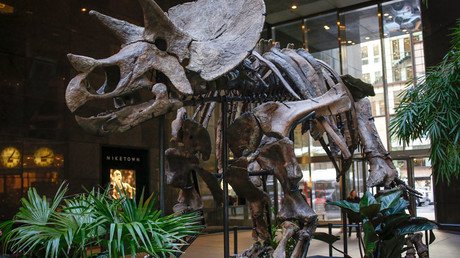NASA to land on asteroid that could have once seeded life, but may now destroy Earth

NASA is about to launch a $1 billion 7-year mission to probe asteroid Bennu, which may carry the building blocks of organic life, but also has a chance of hitting Earth late in the next century.
“It may be destined to cause immense suffering and death,” Dante Lauretta, professor of planetary science at Arizona University and the lead researcher on the OSIRIS-REx mission, told the Sunday Times.
Discovered in 1999, Bennu measures about 500 meters across, weighs over 60 million tons, and travels at over 100,000 kilometers per hour.
How big is my favorite #asteroid#Bennu? Much bigger than I am -- and taller than the @EmpireStateBldg. #AsteroidDaypic.twitter.com/5tb0wu4KBi
— OSIRIS-REx (@OSIRISREx) June 30, 2016
Its trajectory is unpredictable due to what is known as the Yarkovsky effect, in which the asteroid absorbs the energy of sunlight and then gives it off as heat, which serves as a thruster that constantly makes slight shifts to its path.
Lauretta says that, if Bennu were to hit Earth, its impact would be equivalent to setting off 3 billion tons of high explosives, similar in potential effect to the asteroid that may have wiped out most life on the planet 66 million years ago – though that asteroid is thought to have been about 10 kilometers (6.2 miles) across.
“We estimate the chance of impact at about one in 2,700 between 2175 and 2196,” said Lauretta.
While OSIRIS-REx will help refine our estimate of the asteroid’s trajectory, largely by helping researchers to get a better grasp on its Yarkovsky effect, this is not the prime reason for sending it to Bennu, which is named after an Egyptian deity.
Aged over 4 billion years, Bennu is a contemporary of asteroids that, according to a hypothesis known as Panspermia, could have brought new elements and water to Earth in its early stages, giving it a ready-made foundation from which life may have emerged.
“Bennu is a carbonaceous asteroid, an ancient relic from the early solar system that is filled with organic molecules,” said Lauretta. “Asteroids like Bennu may have seeded the early Earth with this material, contributing to the primordial soup from which life emerged.”
To learn Bennu’s secrets, the 1.7-ton OSIRIS-REx, which is due to be launched on September 8, is equipped with one of the most sophisticated scanning suites in space exploration history.

When the spacecraft approaches the asteroid in 2018, it will first carefully examine it with visible and infrared spectrometers to determine which parts of the asteroid are likely to contain the most biologically interesting samples.
It will land only after identifying the perfect spot for collecting a sample of between 60 grams and one kilogram. The capsule containing the material will then be thrust towards Earth, where it will hopefully land somewhere in Utah in 2023.
“We need to know everything about Bennu – its size, mass and composition,” said Lauretta. “This could be vital data for future generations.”













